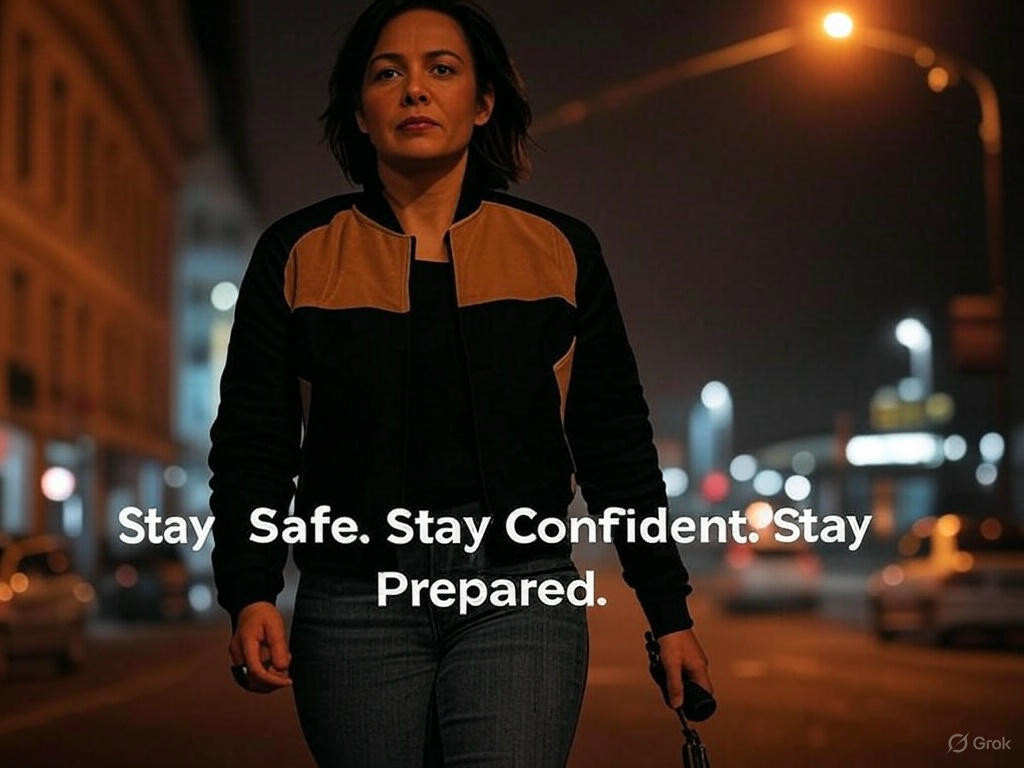Women’s Safety Guide: Top Self-Defense Tips

Every woman deserves to feel safe and confident in her daily life, whether walking to work, traveling solo, or relaxing at home. Unfortunately, safety concerns like harassment, theft, and assault can create uncertainty. That’s why understanding self defense for women tips is so important—they empower you to take control of your security. At TBOTECH, we’re committed to helping you stay protected with practical strategies and top self-defense tools. This guide provides essential tips for staying safe in public, securing your home, traveling with confidence, and handling emergencies, ensuring you’re prepared for any situation.
Why Women’s Safety Requires Proactive Strategies
Women face unique safety challenges in their daily lives, from navigating public spaces to ensuring the security of their homes. Being proactive isn’t about living in fear—it’s about building confidence through preparation. Here’s why a strategic approach matters:
- Public Risks: Women are often targets for harassment, theft, or assault in public spaces, especially when alone or distracted.
- Home Vulnerabilities: Homes without proper security measures can attract intruders, particularly when women live alone.
- Travel Concerns: Solo travel can expose women to risks, such as theft or unsafe accommodations, if not planned carefully.
- Emergency Preparedness: Knowing how to respond to threats can make the difference between escaping safely and facing harm.

Avoid Distractions to Stay Alert
By adopting the right habits and tools, you can address these risks and feel empowered in any scenario. Let’s dive into actionable tips to keep you safe every day.
Self-Defense Tips for Women: Stay Safe in Every Scenario
These practical strategies will help you protect yourself in various aspects of daily life, from public outings to solo travel. Each section includes tailored advice and TBOTECH products to improve your safety.
1. Staying Safe in Public Spaces
Public spaces like streets, parks, and transit hubs can pose risks, but awareness and preparation can keep you safe:
- Stay Alert: Limit distractions—avoid texting or wearing earbuds in both ears. Keep your head up and scan your surroundings for suspicious behavior, like someone lingering nearby.
- Choose Safe Routes: Stick to well-lit, populated areas, especially at night. Avoid shortcuts through alleys or empty lots where help isn’t nearby.
- Trust Your Instincts: If someone makes you uncomfortable, act quickly—cross the street, enter a store, or seek help from a bystander or security.
- Be Assertive: If harassed, use a firm voice to say “Leave me alone!” or “Back off!” to draw attention and deter further action.
Recommended Tool: Patterned Pepper Spray – A 0.5 oz pepper spray with an animal print design, delivering an 8.5% Oleoresin Capsicum formula with an 8-foot range, perfect for stylish, discreet protection in public.
2. Securing Your Home Against Intruders
Your home should be a safe haven—use these strategies to deter threats and protect your space:
- Reinforce Entry Points: Install deadbolts on doors and window locks to prevent easy access. Consider adding a window alarm for extra security.
- Increase Visibility: Use motion-sensor lights around your property to deter intruders by illuminating dark areas.
- Create the Illusion of Occupancy: Leave a light on, use timers for lights or TVs, or vary your car’s parking spot to suggest someone’s home.
- Secure While Away: Ask a trusted neighbor to check on your home, collect mail, or park in your driveway while you’re gone.
Recommended Tool: Door Stop Alarm – A 120-decibel alarm that wedges under your door, alerting you if someone tries to enter, ideal for home or travel security.
3. Traveling Safely as a Woman
Solo travel can be empowering, but it requires extra precautions to stay safe on the go:
- Plan Ahead: Research your destination to identify safe areas, reliable transportation options, and emergency contacts, such as local police or embassies.
- Protect Valuables: Minimize cash—use cards or digital payments. Keep valuables hidden in a secure bag or money belt to avoid attracting thieves.
- Stay Connected: Share your itinerary with a trusted friend, and use live tracking apps to share your location during outings.
- Hotel Safety: Choose a room near the elevator, avoid rooms on the ground floor, and request a room change if you feel unsafe. Use a door stop alarm for added security.
My Kitty Keychain for Self-Defense
Recommended Tool: Travel Safety Kit for Women – A compact kit with a personal alarm, pepper spray, and stun gun, designed to keep you protected while traveling.
4. Navigating Daily Life: On the Go and at Night
Daily routines, such as commuting or running errands, can expose you to risks, especially at night. Here’s how to stay safe:
During the Day
- Secure Belongings: Use a cross-body bag to prevent theft and keep it in front of you in crowded places, such as markets or buses.
- Ride-Sharing Safety: Verify the driver’s name, vehicle details, and license plate before entering. Sit in the back and share your trip with a friend.
- Parking Lot Awareness: Have your keys ready before reaching your car, check the backseat, and park near entrances or under lights.
At Night
- Stick to Well-Lit Paths: Walk on main streets with streetlights, avoiding dark alleys or shortcuts.
- Travel with Others: Use a buddy system for nightlife outings, and watch each other’s drinks to prevent tampering.
- Be Ready to Act: If followed, head to a safe location, such as a 24-hour store, and call for help. For more tips, see our guide on Walking Alone at Night.

Stay Safe While Traveling Alone
Recommended Tool: Stun Gun with Wrist Strap Pink – A 16.5 million volt stun gun with a wrist strap and disable pin, featuring a pink design for stylish protection on the go or at night.
5. Responding to Threats with Confidence
If faced with a threat, knowing how to respond can keep you safe. Here’s how to handle dangerous situations:
- De-Escalate First: Use a firm voice to say, “Stay back!” while maintaining a safe distance. Avoid escalating unless necessary.
- Make Noise: Yell “Help!” or activate a personal alarm to attract attention and scare off the attacker.
- Use Self-Defense Techniques: Target vulnerable areas like the eyes, nose, or groin with a tool or your hands, then run to safety. For specific moves, see our guide on Basic Self Defense for Women.
- Escape and Report: Prioritize escape over confrontation—run to a safe place and report the incident to authorities as soon as possible.
Recommended Tool: Personal Alarm with Clip Pink – A 120-decibel alarm with a clip for easy attachment to your bag, featuring a pink design and pull-pin activation to draw attention in emergencies.
Top Self-Defense Tools for Women: Stay Protected with TBOTECH
Equipping yourself with the right tools can boost your confidence and preparedness. TBOTECH offers a range of women-focused self-defense products to keep you safe in any situation:
- Rhinestone Pepper Spray: A 0.5 oz pepper spray with a rhinestone design, delivering an 8.5% Oleoresin Capsicum formula with an 8-foot range, perfect for stylish, discreet protection in public. Shop Rhinestone Pepper Spray
- Stun Gun with Wrist Strap Pink: A 16.5 million volt stun gun with a wrist strap and disable pin, featuring a pink design for stylish protection on the go or at night (verify local laws before carrying). Shop Stun Gun with Wrist Strap Pink
- Personal Alarm with Clip Pink: A 120-decibel alarm with a clip for easy attachment to your bag, featuring a pink design and pull-pin activation to draw attention in emergencies. Shop Personal Alarm with Clip Pink
- Keychain Weapon with Heart Design: A 3.5-inch keychain weapon with a pointed end for striking, featuring a heart-shaped design for a feminine touch, ideal for everyday carry. Shop Keychain Weapon with Heart Design
- Door Stop Alarm: A 120-decibel alarm that wedges under your door, alerting you if someone tries to enter, perfect for home or travel security. Shop Door Stop Alarm
- Travel Safety Kit for Women: A compact kit with a personal alarm, pepper spray, and stun gun, designed to keep you protected while traveling. Shop Travel Safety Kit for Women
Explore More Women’s Safety Resources
Check out these TBOTECH resources:
- Basic Self Defense for Women: Moves, Tips, and Tools – Learn physical self-defense techniques for women.
- Walking Alone at Night: Top Safety Tips for Protection – Tips for staying safe after dark.
- Shop Stun Guns – Reliable close-range protection.
- Shop Pepper Spray – Affordable and effective defense.
Empower Yourself with TBOTECH
Women’s safety is about empowerment through preparation. By adopting these self-defense tips and equipping yourself with TBOTECH’s top safety tools, you can navigate daily life with confidence. Have a safety tip to share? Drop it in the comments below—we’d love to hear from you! Ready to gear up? Shop TBOTECH’s self-defense tools today and take control of your security.
Add your comment now!
Post CommentRecent posts
-
06/27/2025Personal Safety Devices for Women
-
06/27/2025Can You Bring Pepper Spray on a Plane?
-
06/27/2025Are Butterfly Knives Illegal?

